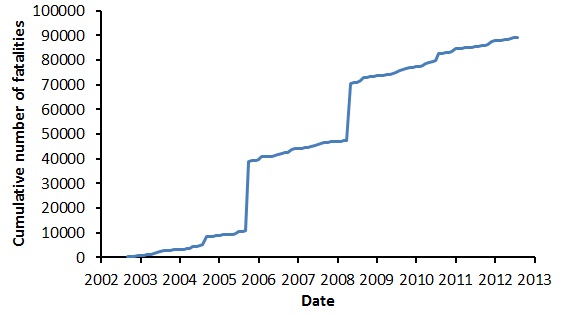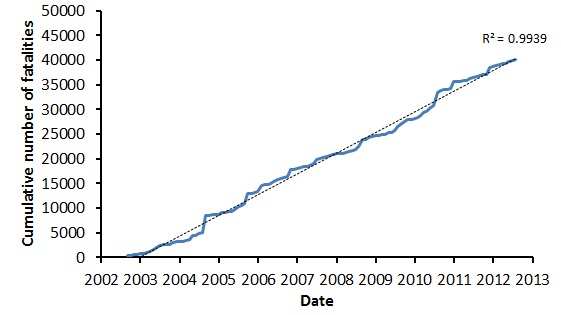13 September 2012
Ten years of collecting landslide fatality data
Posted by Dave Petley
Ten years ago, on 1st September 2002, I started a small experiment to try to collect data on landslides that kill people. The key findings of that research to date were recently published in Geology, although I should note that the paper covered ony seven of the 10 years of data, and only covered non-seismic landslides. I am still happy to email a copy of the paper to anyone who wants it by the way, and hope that I will soon have an online version for free download (once the page charges have been paid by my university).
People often ask why I started to collect this dataset. The initial trigger was a question asked by a friend from another field, who enquired as to how many people die from landslides each year. I suddenly realised that not only did I not know, but that there was no credible dataset that addressed the question. I decided that the newly available news aggregator tools, such as Google News, might offer an opportunity to collect this sort of data, So I must admit that when I set out to do this I did not expect it to last long, or indeed to generate a scientically interesting dataset. That it has been both long-lived and scientically valuable has been a surprise.
The resulting dataset provides a very particular view of landslides. The focus on landslides that kill people means that those countries that have tried to reduce landslide losses do not appear strongly in the dataset, even though they may have many landslides, whilst those that have no such programmes tend to be heavily represented. A dataset on economic costs of landslides would have a very different spatial distribution of events (with the highest costs being in more developed countries). Thus, this data should perhaps be seen as the realisation of landslide mortality risk. Even then there is a caveat. The dataset does not include a really large El Nino event, such as that in 1997. It is likely that the spatial distribution of landslides looks quite different in such years. Thus, the dataset will not be truly representative until it covers such an event. I am guessing that this shortcoming will be put right in the next few years, and with an E Nino starting to develop at the moment, the next year could be very interesting.
So let’s briefly examine the ten years of data. The graph below shows the cumulative total number of fatalities from landslides over the ten-year period. I have recorded a total of 89,177 fatalities from landslides in the decade, which of course represents an annual global toll of almost 9,000 people per year.
 The dataset is dominated by two large steps – one in October 2005 and the other in May 2008. These are the landslides triggered first by the 2005 Kashmir earthquake in Pakistan and India, and second by the 2008 Wenchuan earthquake in China. It could be that the occurrence of two large earthquakes in mountain areas is unusual, inflating the overall totals in comparison with other decades. Time will tell. I should also note that I recorded almost no fatalities from the 2010 Haiti earthquake, even though it is likely that many of the deaths were associated with slope failures under slum houses. In this way, and in the sense that it is likely that I have missed some events, the dataset is almost certainly an under-representation of true landslide losses.
The dataset is dominated by two large steps – one in October 2005 and the other in May 2008. These are the landslides triggered first by the 2005 Kashmir earthquake in Pakistan and India, and second by the 2008 Wenchuan earthquake in China. It could be that the occurrence of two large earthquakes in mountain areas is unusual, inflating the overall totals in comparison with other decades. Time will tell. I should also note that I recorded almost no fatalities from the 2010 Haiti earthquake, even though it is likely that many of the deaths were associated with slope failures under slum houses. In this way, and in the sense that it is likely that I have missed some events, the dataset is almost certainly an under-representation of true landslide losses.
If earthquake-induced fatalities are removed then the graph of the cumulative total number of fatalities looks like this:
 In total, I have recorded 40,123 non-seismically induced landslide fatalities in the ten year period. The black dotted line above is the automatically-generated linear best fit line for the data (for illustration purposes only of course). It is remarkable just how linear the trend is over this time period. The last year or so appears to be a comparatively low landslide period, whilst 2010 was notably higher. This is likely to reflect aspects of the global atmospheric system (for example the ENSO cycle, the state of the Asian monsoon, and the rather complex patterns of occurrence of landfalling tropical cyclones). However, in many ways this dataset is analogous to a weather dataset. In the case of the latter 30 years of data are needed before a statistically-significant trend analysis can be undertaken. Unfortunately, it is likely that I have a another 20 years of data collection to undertake before the long-term trend can be properly interpreted. Thus, this research will take me to, and perhaps even beyond, my formal retirement point. It will truly be my lifetime’s work.
In total, I have recorded 40,123 non-seismically induced landslide fatalities in the ten year period. The black dotted line above is the automatically-generated linear best fit line for the data (for illustration purposes only of course). It is remarkable just how linear the trend is over this time period. The last year or so appears to be a comparatively low landslide period, whilst 2010 was notably higher. This is likely to reflect aspects of the global atmospheric system (for example the ENSO cycle, the state of the Asian monsoon, and the rather complex patterns of occurrence of landfalling tropical cyclones). However, in many ways this dataset is analogous to a weather dataset. In the case of the latter 30 years of data are needed before a statistically-significant trend analysis can be undertaken. Unfortunately, it is likely that I have a another 20 years of data collection to undertake before the long-term trend can be properly interpreted. Thus, this research will take me to, and perhaps even beyond, my formal retirement point. It will truly be my lifetime’s work.


 Dave Petley is the Vice-Chancellor of the University of Hull in the United Kingdom. His blog provides commentary and analysis of landslide events occurring worldwide, including the landslides themselves, latest research, and conferences and meetings.
Dave Petley is the Vice-Chancellor of the University of Hull in the United Kingdom. His blog provides commentary and analysis of landslide events occurring worldwide, including the landslides themselves, latest research, and conferences and meetings.
I look forward to reading your paper. Of course there must be many reasons the number of fatalities from landslides is increasing so dramatically – more people chief among them, also melting ice, and heavier precipitation from our destabilized climate.
However I am particularly interested in your graph because I have been expecting just such a trend based on my observations and readings that indicate a widespread trend for vegetation to be dying off. It would seem inevitable that slopes will become more likely to give way when roots no longer hold the soil and absorb precipitation.
Although it is well-documented that plants that absorb tropospheric ozone are damaged, and that the persistent background level of air pollution is inexorably rising, even in remote locations, few people have followed these facts to their obvious conclusion. Actually there is a huge amount of resistance to it, I’ve found.
Trees as well as other plants, including agricultural crops, lose root structure even before injury from air pollution (stippling, loss of chlorophyll, and shriveling) is visible on leaves and needles, as they must devote more energy to repair of foliage. This causes them to be more vulnerable to drought and wind. Eventually, they lose immunity to insects, disease and fungus, so these subsequent biotic attacks are generally blamed for the demise of forests.
The consequences of this rapidly accelerating trend are myriad and profound (which is no doubt why very few people will acknowledge the obvious). Wildfires are more frequent and larger, and as I expected, I now see that landslides are causing more severe impacts. Ultimately, on top of the loss to agricultural quality and yield, we will lose the most important carbon sink next to phytoplankton, which will vastly intensify global warming.
I put together a book with links to research about ozone which is available for a free download here, if you are interested: http://www.deadtrees-dyingforests.com/pillage-plunder-pollute-llc/
Thanks for your ongoing study of landslides.
Gail
new landslide: http://economictimes.indiatimes.com/news/politics/nation/cloudburst-33-killed-35-missing-in-uttarakhand/articleshow/16405788.cms